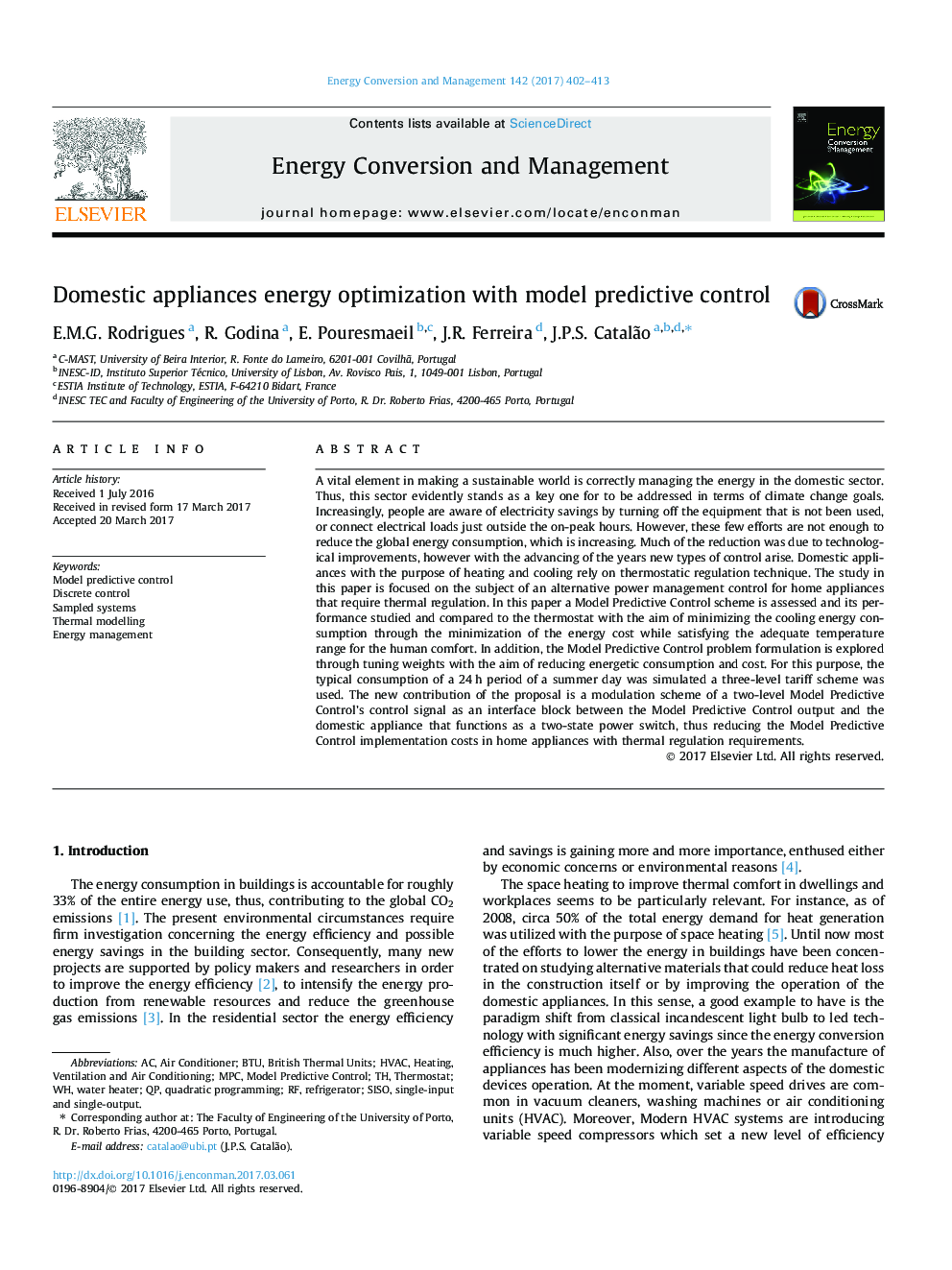| کد مقاله | کد نشریه | سال انتشار | مقاله انگلیسی | نسخه تمام متن |
|---|---|---|---|---|
| 5012815 | 1462820 | 2017 | 12 صفحه PDF | دانلود رایگان |
عنوان انگلیسی مقاله ISI
Domestic appliances energy optimization with model predictive control
ترجمه فارسی عنوان
بهینه سازی انرژی لوازم خانگی با کنترل پیش بینی مدل
دانلود مقاله + سفارش ترجمه
دانلود مقاله ISI انگلیسی
رایگان برای ایرانیان
کلمات کلیدی
ترجمه چکیده
یک عنصر حیاتی در ایجاد یک جهان پایدار به درستی مدیریت انرژی در بخش داخلی است. به این ترتیب، این بخش آشکارا یکی از مهمترین موضوعاتی است که باید از نظر اهداف تغییر آب و هوا مورد توجه قرار گیرد. مردم بیشتر از صرفه جویی در مصرف برق با خاموش کردن تجهیزاتی که استفاده نشده اند و یا بارهای الکتریکی را فقط در محدوده ساعت های پیک در نظر می گیرند، آگاه هستند. با این حال، این تلاش های چندگانه برای کاهش مصرف انرژی جهانی که افزایش می یابد کافی نیست. بخش عمده ای از کاهش به علت پیشرفت های تکنولوژیکی بود، با این حال با پیشرفت سال ها، نوع جدیدی از کنترل ایجاد می شود. لوازم خانگی با هدف گرمایش و خنک کننده به تکنیک تنظیم دما میپردازند. مطالعه در این مقاله بر روی موضوع کنترل قدرت جایگزین برای لوازم خانگی که نیاز به تنظیم حرارتی دارند متمرکز شده است. در این مقاله، یک مدل کنترل پیش بینی مدل ارزیابی شده است و عملکرد آن مورد بررسی و مقایسه با ترموستات با هدف به حداقل رساندن مصرف انرژی خنک کننده از طریق به حداقل رساندن هزینه انرژی در حالی که رضایت دامنه مناسب کافی برای آسایش انسان است. علاوه بر این، فرمولبندی مسئله کنترل پیشبینی مدل با استفاده از وزنهای تنظیم شده با هدف کاهش مصرف انرژی و هزینهها مورد بررسی قرار میگیرد. برای این منظور، استفاده معمول از یک دوره 24 ساعته در یک روز تابستانی شبیه سازی شده بود که طرح تعرفه ای سه سطحی مورد استفاده قرار گرفت. سهم جدید این پیشنهاد، یک طرح مدولاسیون کنترل دوگانه کنترل پیش بینی کنترل مدل به عنوان یک بلوک رابط بین خروجی کنترل پیش بینی مدل و لوازم خانگی است که به عنوان یک سوئیچ توان دو حالت عمل می کند، در نتیجه کاهش کنترل مدل پیش بینی هزینه های پیاده سازی در لوازم خانگی با مقررات حرارتی مورد نیاز.
موضوعات مرتبط
مهندسی و علوم پایه
مهندسی انرژی
انرژی (عمومی)
چکیده انگلیسی
A vital element in making a sustainable world is correctly managing the energy in the domestic sector. Thus, this sector evidently stands as a key one for to be addressed in terms of climate change goals. Increasingly, people are aware of electricity savings by turning off the equipment that is not been used, or connect electrical loads just outside the on-peak hours. However, these few efforts are not enough to reduce the global energy consumption, which is increasing. Much of the reduction was due to technological improvements, however with the advancing of the years new types of control arise. Domestic appliances with the purpose of heating and cooling rely on thermostatic regulation technique. The study in this paper is focused on the subject of an alternative power management control for home appliances that require thermal regulation. In this paper a Model Predictive Control scheme is assessed and its performance studied and compared to the thermostat with the aim of minimizing the cooling energy consumption through the minimization of the energy cost while satisfying the adequate temperature range for the human comfort. In addition, the Model Predictive Control problem formulation is explored through tuning weights with the aim of reducing energetic consumption and cost. For this purpose, the typical consumption of a 24Â h period of a summer day was simulated a three-level tariff scheme was used. The new contribution of the proposal is a modulation scheme of a two-level Model Predictive Control's control signal as an interface block between the Model Predictive Control output and the domestic appliance that functions as a two-state power switch, thus reducing the Model Predictive Control implementation costs in home appliances with thermal regulation requirements.
ناشر
Database: Elsevier - ScienceDirect (ساینس دایرکت)
Journal: Energy Conversion and Management - Volume 142, 15 June 2017, Pages 402-413
Journal: Energy Conversion and Management - Volume 142, 15 June 2017, Pages 402-413
نویسندگان
E.M.G. Rodrigues, R. Godina, E. Pouresmaeil, J.R. Ferreira, J.P.S. Catalão,
